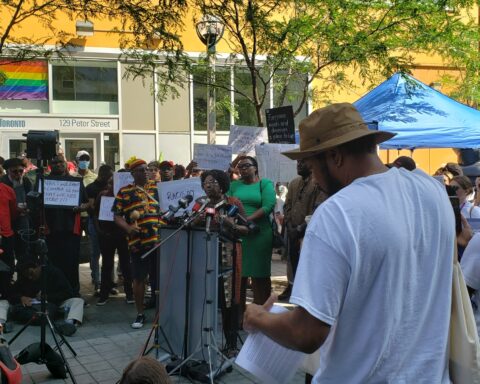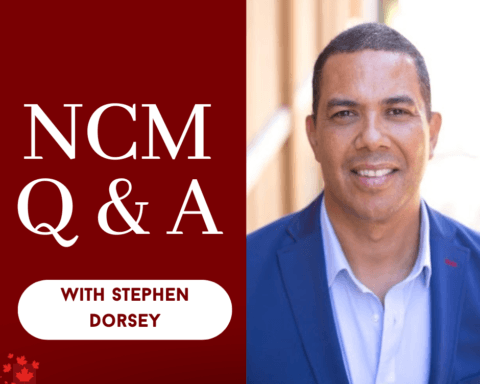Canada has been singularly successful as a multicultural nation. While Europe and America have torn themselves apart over issues of immigration and race, we’ve been lucky in avoiding strife. Our luck may be running out.
Our polling is tracking an erosion of Canadians’ openness to diversity and immigration. Much of this may be due to a looming federal election in which rhetoric about terrorism and cultural accommodation is bound to play a prominent role. Attitudes to immigration are in flux and we appear to be turning into a less open society.
Questions of race and religious dress have rarely been ballot box issues in Canada. Now, however, they appear to be the key factors behind major shifts in the voter landscape.
When we look at how attitudes on immigration and race spread out among the main federal parties, a pattern emerges. Liberals and New Democrats have no cause to be smug; fully one-third of their supporters think too many of those coming to Canada are visible minorities.
Canada has absorbed a large number of visible minority immigrants over the past twenty years, turning us from a largely white society with ancestry drawn from Britain and France to an extremely heterogeneous one. Initial deep reservations about immigration dropped consistently over that period as we became more diverse. The public embraced the ideal of multiculturalism; dire warnings about ethnic enclaves and a fading national identity never came true. Our research over that period shows national attachment remained very high in Canada, while ethnic identifications actually dropped.
It’s useful to remember how far apart public opinion in Canada and the United States was following the 9/11 terrorist attacks. In both countries there was a sharp, immediate rise in opposition to immigration. In Canada, however, that trend soon dissipated, reaching an all-time low around 2005 — when only 25 per cent of us said there were too many immigrants and less than one in five said that too many immigrants were visible-minority. In the U.S., the level of opposition to immigration was nearly three times higher. Canada remained a nation open to the world: pro trade, pro-immigration and pro-diversity. This seemed to confer both social and economic advantages.
But something has changed.

Recent polling shows opposition to immigration has nearly doubled since 2005 and is threatening to crack the 53 per cent level we saw in 1993. Not only is opposition to immigration in general scaling heights not seen in twenty years but the number of Canadians saying we admit too many visible minorities has just cracked the 40-point ceiling for the first time ever.

And let’s be clear about this. Opposition to immigration can be driven by factors other than racial discrimination, such as economic anxiety. But it’s hard to see how those saying too many immigrants are visible-minority can be motivated by anything but racial or cultural bias. It may not be particularly insidious but it is racial intolerance — and these numbers should alarm anyone who believes in an open and tolerant society.
Questions of race and religious dress have rarely been ballot box issues in Canada. Now, however, they appear to be the key factors behind major shifts in the voter landscape.
When we look at how attitudes on immigration and race spread out among the main federal parties, a pattern emerges. Liberals and New Democrats have no cause to be smug; fully one-third of their supporters think too many of those coming to Canada are visible minorities.
But it’s the Conservative party — which owes much of its current success to wooing votes from new Canadians — that seems to have the problem. Jason Kenney, to his credit, wants new Canadians in his party’s corner. But half of the people who support his party would prefer to see fewer non-white immigrants.

A personal note now. We were tracking public opinion on race and immigration in Toronto in the early 1990s. One of the things that struck me vividly about the immigration debate back then was how emotional it was. We quickly learned that mixing visible minorities with white participants in our focus groups was a practice to be avoided at that time.
Many Canadians from white European backgrounds were displaying aggravated cultural insecurities — about not being allowed to say the Lord’s Prayer in school anymore, about the so-called ‘war on Christmas’, about scary-looking foreigners on the subway, about Mounties in turbans. It was a toxic stew of fear and hostility, one that might look utterly alien to anyone who only knows the relatively harmonious and culturally diverse Toronto of today.

Given the intensity of those debates, and how they faded with time, let’s consider how current views on the niqab might change. As once can readily see, Prime Minister Stephen Harper’s opposition to face veils worn in citizenship courts enjoys broad public support. There is also a very strong correlation between those who agree with the prime minister’s position and those who think there are too many visible minorities coming to Canada. Not all of those who agree with Harper on the niqab think we admit too many visible minorities — but virtually all of those who do think we admit too many visible minorities also support the ban.

And we can clearly see how these attitudes have shifted the landscape going into the election. The Conservative party’s polling resurgence has happened in precisely the demographics where less-tolerant attitudes towards visible minorities and the niqab are strongest. Among Bloc Quebecois suppporters, 64 per cent oppose visible minority immigration and a whopping 86 per cent support the ban on the niqab at citizenship ceremonies.
It’s hard to tell at this point how the immigration/race question might affect the trajectory of the election. What we do know is that this topic is doing more to sort the electorate by party than many more pressing issues, such as the moribund economy.
This is, in fact, the first really explicit political debate about values that we’ve seen in Canadian politics in a long time. The old reticence to discuss this issue has been shattered. Which path will Canadians choose?
Frank Graves is the founder and president of EKOS Research. To see the methodology behind any of the statistics presented, please see the original article.
Re-published in partnership with iPolitics.ca




